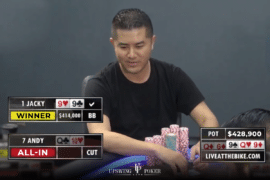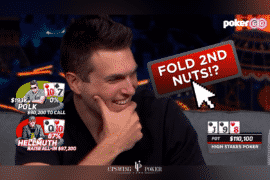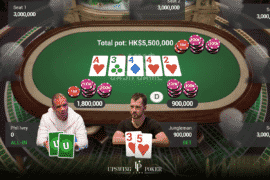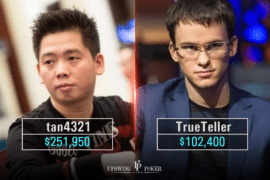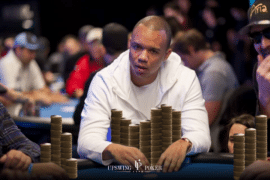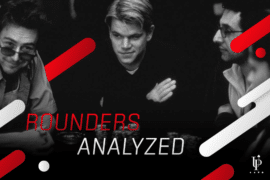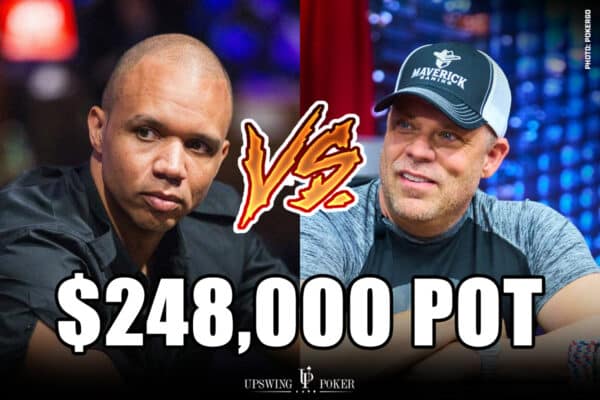
Phil Ivey Plays $248,000 Pot vs Eric Persson (Analysis)
Let’s take a look at a big pot that features a very interesting play by Phil Ivey.
His opponent in the hand is poker enthusiast and casino owner Eric Persson.
This took place on a Hustler Casino Live show last year. The blinds were $200/$400/$800/$1,600 with a $400 Big Blind ante. The effective stack between the two is roughly $480,000.
In other words… this is massive stakes poker.
Let’s jump in!
Preflop Action
Phil Ivey raises to $5,400 from the Button with As Qs. Eric Persson calls with Jh 5h from the straddle.
Preflop Analysis
Phil should be raising with a fairly wide range in this spot. Ace-Queen offsuit is obviously good enough. There are 4 players behind, but they are all out of position against Phil and there is a lot of dead money in the pot already. Raising with roughly the top 40% of hands is the most profitable strategy here.
Eric is getting good pot odds, only needing to realize about ~30% equity to make a profitable call. J5-suited has ~40% raw equity against Phil’s likely raising range. This is much more than enough to make it a +EV (expected value) call.
Both players have played their hands well so far.
Flop Action
The flop comes Js 7h 6c. The pot is $12,600.
Eric checks. Phil checks.
Flop Analysis
Eric should check his entire range to the preflop raiser on this flop, as he does.
Phil has the stronger range on this board — he’s more likely to have a strong top pair or overpair.
Phil’s missed hands are also stronger than Eric’s. He can have hands like Ace-King, Ace-Queen, Ace-Ten suited, and King-Queen suited, all of which Eric should be 3-betting with preflop.
For these reasons, Phil should bet frequently in this situation. A small bet size (around 33% of the pot) would be best.
Advanced note: A small bet by Phil incentivizes Eric to check-raise with strong hands, which leaves Eric’s range more capped should he call.
As Qs is a great hand with which to bet small here, something like ~$4,000. With two overcards, a backdoor nut flush draw, and a backdoor straight draw, it’s a great semi-bluff with a ton of playability. Checking back certainly isn’t a terrible move, though.
Turn Action
The turn comes the 4h, making the board Js 7h 6c 4h. The pot is $12,600.
Eric bets $7,600. Phil calls.
Turn Analysis
The turn 4h is one of the best possible outcomes for Eric. The hands with which Phil checks on the flop (mostly Ace-high and King-high hands) don’t improve often on this turn.
A medium-sized bet works very well for Eric’s range. He is able to value bet with all of his top pairs and better. He can balance that value range by bluffing with flush draws, open-ended straight draws, and gutshot straight draws (with a smidge of overcard+flush draw blocker hands such as Kh Tx, Kx Th, Kh 9x, Kx 9h, etc.).
Against this bet, Phil should call with As Qs, at least sometimes, because he is ahead of a large part of Eric’s range. Plus, he has equity against a good chunk of the value range with the two overcards to the top pair.
Well played by both players on the turn.
River Action
The river comes the Th, making the board Js 7h 6c 4h Th. The pot is $27,800.
Eric overbets $29,600. Phil bluff-raises to $110,000. Eric snap-calls and gets shipped the $248,000 pot.
River Analysis
The river Th is an above-average one for Eric. A lot of his range now has just enough equity to extract value (hands like Jx) and those hands cannot bet big. Thus, he should implement a small bet strategy that contains both those thin value hands and stronger ones, such as:
Of course, this range would be balanced by an appropriate amount of bluffs (at equilibrium).
That being said, Eric chooses a small overbet for his flush, which is fine. It’s not an overplay, but it leaves holes in his overall strategy.
Phil’s decision to bluff-raise is flat-out wrong from a theoretical perspective. His blockers don’t work well for the range that he is targeting. He should be looking to do this with a heart in his hand.
That being said, it’s clear that Phil was attempting to make an exploitative move, expecting Eric to have a range of hands that would fold too often to his raise. Given that Phil is arguably the greatest player of all-time, it’s fair to assume he had a good reason for thinking this.
Eric has to call against this raise as it is simply too strong of a hand to fold, blocking many of Phil’s potential value hands.
Final Thoughts
Surprisingly, Eric Persson arguably played this hand better than the GOAT, Phil Ivey.
Does this mean that he is a better poker player than Phil? Well, let me ask you this: If a player dunked on Michael Jordan once, does that mean he’s a better player?
Of course, the answer is no. The same is true in poker. What matters is that the whole body of work (aka decisions) is superior to that of your opponents.
That’s all for this article! I hope you enjoyed it and that you learned from it! As usual, if you have any questions or feedback feel free to leave a comment in the section down below.
If you want more high stakes hand analysis, check out Poker Coach Rivers The Nuts in High Stakes Cash Game ($26,543 Analysis).
Till’ next time, good luck, grinders!


